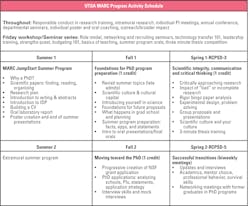The MARC Program at UTSA
At the University of Texas at San Antonio (UTSA), we have a diverse student population that includes many aspiring scientists. To support these budding researchers, UTSA has been a training site for the federally funded Maximizing Access to Research Careers (MARC) research training program for more than four decades.
Since 1980, we’ve admitted 250 undergraduate students to enroll in this competitive research-focused track. In this two-year program, our MARC students are immersed in a culture of science as they prepare to complete a biomedical, research-focused higher degree program. UTSA is one of 57 active MARC programs across the country. Our success is always focused on one student at a time. Alumni of the program have gone on to complete graduate research training at leading institutions including Stanford, University of Pennsylvania, UC Berkeley, and Harvard Medical School.
MARC programs vary according to a campus’ infrastructure, its student population, and the strategies it uses to prepare its trainees for doctoral program admission. UTSA’s MARC program is supported by 40 full-time faculty in the Departments of Biology, Chemistry, Physics, Biomedical Engineering, and Psychology. Our MARC scientists work in the laboratory alongside these nationally recognized researchers for 15 hours per week during the school year. In the first summer, their programs become more intense and they complete 40 hours.
Along with research access, UTSA MARC provides students with a curriculum that stresses scientific integrity, oral communication, critical thinking, and the importance of technology transfer. Specifically, we discuss experimental design, problem solving, and practical skills such as three-minute thesis training and how to write winning National Science Foundation (NSF) grant proposals. Our MARC graduates leave the program with a strong curriculum vitae (CV) and experiences that develop scientific rigor, including experience in peer reviews where their research papers get measured against the highest standards.
The National Institutes of Health (NIH) requires all MARC trainees to be full-time students. It also recommends selection of students who are underrepresented in sciences, financially disadvantaged, or have a disability. At UTSA, we serve a large Hispanic and first-generation college student population. We focus on providing our students with extra support such as credited curriculum to develop vision casting/goal setting and independent development plans (IDP). The IDP works in concert with the CV to help trainees plan for careers in science and map out their final two undergraduate years.
The typical undergraduate IDP includes a course schedule and application deadlines, as well as a summer reserved for an extramural research internship, abstract deadlines, dates to attend a professional conference, a GRE timeline, and application deadlines for desired doctoral programs.
At UTSA, we go one step further by having our students prepare for the extremely prestigious National Science Foundation Graduate Research Fellowship due in October of their senior undergraduate year. This past year three of our MARC trainees won this prize.
The NSF Graduate Research Fellowship Program (GRFP) helps ensure the vitality of the human resource base of science and engineering in the United States and reinforces its diversity. The program recognizes and supports outstanding graduate students in NSF-supported science, technology, engineering, and mathematics disciplines who are pursuing research-based master’s and doctoral degrees at accredited U.S. institutions.1
As the oldest graduate fellowship of its kind, the GRFP has a long history of selecting recipients who achieve high levels of success in their future academic and professional careers. The reputation of the GRFP follows recipients and often helps them become life-long leaders that contribute significantly to both scientific innovation and teaching.1
Since 1952, NSF has funded over 50,000 Graduate Research Fellowships out of more than 500,000 applicants. Currently, 42 Fellows have gone on to become Nobel laureates, and more than 450 have become members of the National Academy of Sciences. In addition, the Graduate Research Fellowship Program has a high rate of doctorate degree completion, with more than 70 percent of students completing their doctorates within 11 years.1
Due to the comprehensive training that our students receive in research laboratory practice, as well as the PhD application process, during the 2011 to 2016 award period, 67.6 percent of our MARC graduates continued their education to pursue a doctorate degree.
Our program also has an impact on laboratory and ancillary scientific skills by opening the door to engagement in scientific research for most trainees. On a research evaluation, UTSA MARC participants gave the program an overall rating of 4.89 out of 5 on a Likert Scale.
Recent UTSA graduate Robert Trevino said, “I am forever grateful to the MARC program as I do not think I would even have the dreams that I have without the experiences I have had in this program. I am looking forward to a career as a clinical scientist, and I understand that I owe that to the MARC program.”
The future of UTSA MARC will change as another NIH-funded program will be adopted. UTSA will transition into the Research Initiative for Scientific Enhancement (RISE; R25) program which will take the best of the MARC curriculum to continue to innovate and improve the pipeline that trains the next generation of scientists and researchers.
REFERENCE
- NSF Graduate Research Fellowship Program. htps://www.nsfgrfp.org/general_resources/about. [Accessed July 10, 2019.]
About the Author

Gail P. Taylor, PhD
serves as Associate Director for STEM Initiatives for the UTSA College of Sciences. Gail has also been serving as Assistant Program Director and Training Specialist for the UTSA RISE and MARC programs for almost 20 years. She was honored in 2014 with the UTSA President’s Distinguished Diversity Award and the COS Distinguished Diversity Award for her devotion to assisting underrepresented students achieve their educational goals as biomedical researchers.

J. Aaron Cassill, PhD
serves as Director of STEM Initiatives for the College of Sciences and a Professor of Biology. Cassill joined the UTSA faculty in 1993. He received the Howe Award for Outstanding Service to Undergraduate Students at UTSA in 2002 and the UT Regents’ Outstanding Teaching Award in 2012. In 2013, he received the Piper Professor Award and was inducted into the UTSA Academy of Distinguished Teachers.

Edwin J. Barea-Rodriguez, PhD
serves as the program director of the MARC-U*STAR (Undergraduate Student Training in Academic Research), and RISE (Research Initiative for Scientifc Enhancement) all of which aim to increase underrepresented minority participation in STEM fields. He received UTSA’s Richard S. Howe Award for Excellence in Service to Undergraduate Students in 2006 and 2017.

